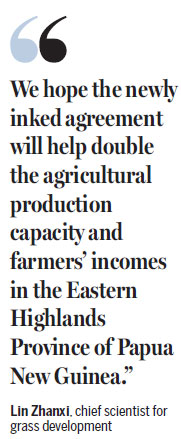Wondrous grass juncao helps alleviate poverty
Plant used to feed livestock, grow mushrooms and is also effective in fight against spread of deserts
PORT MORESBY/FUZHOU - When it comes to poverty relief efforts in the developing world, small is the new big.
Consider juncao, a group of wild grasses that have become one of China's most significant contributions to the world's sustainable development, with multiple uses being shared by people in 105 countries to help tackle food issues and desertification.
China signed an agreement with Papua New Guinea to use the grass technology on Nov 12, one day ahead of the Asia-Pacific Economic Cooperation Leaders' Meeting held in the Pacific island country. It is China's 12th international aid program in poverty relief using the grass.
Juncao, which literally means "the herbal plant for growing edible mushrooms", has worked miracles for Chinese scientists who are cultivating it as a substrate for growing edible and medicinal mushrooms or as forage for livestock, as well as using it as green barrier to stop sand dunes from advancing.
The grass is not new to Papua New Guinea. China introduced the grass and its cultivation technology to the country more than 20 years ago to help local farmers raise livestock and grow edible mushrooms.

In 2017, the yield of the grass in Papua New Guinea set a world record of 854 metric tons per hectare.
The grass grows up to 8 meters tall and is harvested three to six times a year. It contains 11 percent to 17 percent crude protein. The per-hectare harvest of the grass can feed 400-500 sheep or grow 100 tons of fresh fungi.
"We hope the newly inked agreement will help double the agricultural production capacity and farmers' incomes in the Eastern Highlands Province of Papua New Guinea," said Lin Zhanxi, a 76-year-old professor with Fujian Agriculture and Forestry University and the chief scientist for grass development.
The aid program is expected to help lift 30,000 people out of poverty in the province by 2023.
It's been 32 years since Lin selected the grass species to replace timber as a substrate for growing fungi, a local cash cow, in East China's Fujian province, and this has saved a vast coverage of natural forest there.
Through the years, Lin has developed 45 varieties of juncao, which can be used to cultivate 55 mushroom species.
The agricultural technology has been widely promoted at home through China's poverty alleviation projects in western areas including Xinjiang Uygur, Tibet and Ningxia Hui autonomous regions since 1991.
The grass is also planted to fight desertification.
On the banks of the Yellow River, China's second-longest river, a mass planting of juncao grass is underway, aiming to build a 1,000-km long green barrier by 2021 to treat the heavily eroded land and protect it from sand invasion.
The project, initiated by Lin and several Chinese academicians, was sponsored by the Chinese Ministry of Water Resources.
The juncao technology won the Geneva State Prize at the 20th International Invention Exhibition in 1992 and the Prize of French Ministry of Interior and Land Planning at the 85th Paris International Invention Exhibition.
In 1994, the technology was listed by the United Nations Development Program as one of China's priority projects for cooperation with other developing countries.
Since 1992, China has shared the technology with 105 countries by offering training and conducting onsite demonstrations.
FAFU alone has provided training to some 7,000 foreigners. Of them, 15 students from eight countries have obtained the university's graduate and doctorate degrees in the research of juncao technology.
Despite his age, Lin has often traveled afar to help people in developing countries learn about the benefits of this agricultural technology.
"The first time I went to Papua New Guinea in 1997, I realized how people there were struggling with extreme poverty," Lin said.
At that time, a tribe chief knelt down before Lin to thank him for bringing the technique to save them from starvation. To his astonishment, the tribe people celebrated all night long.
Members of the team were so touched that they decided to stay and help the people shake off poverty. In a land without electricity or modern devices, the team members worked there for eight years to teach locals how to cultivate and use the grass.
Lin's daughter Lin Dongmei, also his assistant, has been overseeing the juncao technology projects overseas.
"Every time I arrive at a new place to share juncao technology, I study the local government's policies and collaborate with them to optimize the agricultural planning," she said.
Xinhua
|
Lin Zhanxi (left), the chief scientist who developed juncao, a type of herbal plant, and his students check its growth in a field in Fuzhou, Fujian province. Zhang Guojun / Xinhua |
(China Daily 11/29/2018 page17)















